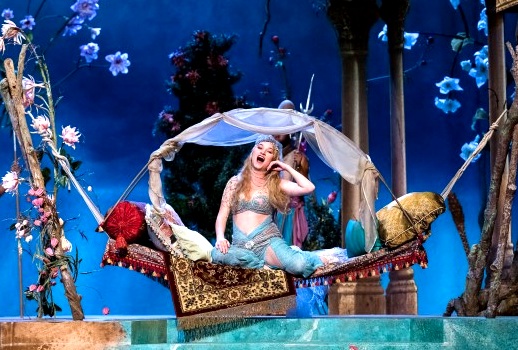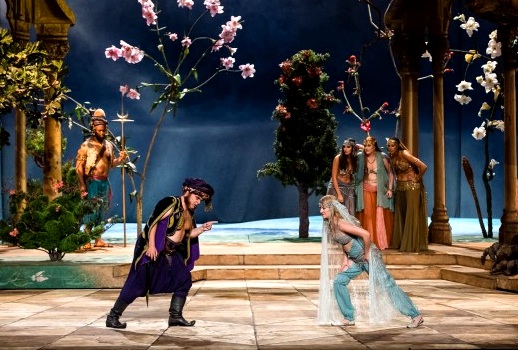

Yet that is precisely the outcome Mozart’s audience expected—Vienna still harboured major suspicions of the Ottomans when this opera was written in the 1780s—and the composer instead offers a more celebratory conclusion, as the couple and their respective sidekicks, Pedrillo and Blonde, are set free to return to Europe. But, of course, not before enjoying a few more “Turkish delights.”
The Paris Opera’s production—directed by Zabou Breitman (known here for her stage acting) and conducted by Paris Opera music director Philippe Jordan—offers plenty of hijinks without detracting from the delicacy of the score. I was delighted to be joined for this performance by a friend who was experiencing her first ever opera, and skthis one proved to be an odd but excellent choice, shattering expectations of loud “parking and barking” with little investment in dramatic play. Not here, dear friend!
Entführung begins at the country house of Pasha Selim in Turkey, and appropriately, Mozart integrates Turkish instrumentation from the overture until the final chords, played onstage by a troupe of colourfully dressed musicians. Belmonte (tenor Bernard Richter in an ardent portrayal, after some warming up) is trying to find Konstanze (soprano Erin Morley, a graduate of the Met’s Lindemann Young Artist Development Program, in a superb, shimmering performance), who has been sold by pirates to Pasha Selim (Jürgen Maurer, suave but vocally underpowered for this speaking role).
Belmonte and his sidekick Pedrillo (likeable tenor Paul Schweinester) are stopped in their tracks by Osmin, the Pasha’s servant (bass Lars Woldt, who bellows and blusters all the way down to a low D). Osmin, meanwhile, has his heart set on Konstanze’s, confidante, Blonde (exuberant soprano Anna Prohaska, who enters on a hammock). This odd lot of characters plot and scheme—and in this production, they take selfies (it was funny the first time…) The cast worked well together as an ensemble, navigating smoothly between the sung and spoken parts in this Singspiel.
Breitman is to be commended for excellent pacing and for allowing Mozart’s intriguing score to guide the staging. He also manages to keep his singers dramatically engaged without overly preoccupying them as they tackle fiendishly virtuosic arias, duets, and ensembles. With the storied Palais Garnier—which today is rarely used for opera performances—Breitman has a glorious sandbox in which to play. The set by Jean-Marc Stehlé looks like something out of a child’s colouring book as if he—like Mozart—was trying to imagine the look and feel of that far-off land known as Turkey.
We see the rough outline of the Pasha’s estate—guarded by bare-chested spear-carriers—and the other set pieces slide ungracefully onstage, as if this new production were as old as the Garnier itself (this was the 96th performance of Entführung by the Paris Opera). That the ensemble lounges about onstage during the intermission adds yet another playful touch.
This opera—famously dismissed by Emperor Joseph II as containing “too many notes”—boats some of Mozart’s most virtuosic vocal writing, and not merely for the two sopranos. As Osmin, Mr. Woldt had to leapfrog across his range and he managed to do so without losing focus on his character’s task, namely frustrating all of Belmonte’s efforts to reunite with Konstanze while keeping a close eye over his beloved Blonde.
Ms. Prohaska—in a slinky turquoise outfit by Arielle Chanty—seemed to exude the confidence of a Lulu rather than a captured maiden who has been promised to an ogre. She sings with great energy and her harder-edged vocal colorings are reminder of the soprano’s recent successes in contemporary opera (Jörg Widmann’s Babylon).

Here we have the chance to hear her in a significantly more intimate house in a role full of demanding coloratura. She succeeds admirably and rises to the challenges of her biggest aria, “Martern aller Arten,” a kind of sinfonia concertante performed with four solo players who are “selected” by the Pasha to come up onstage in their modern black attire. Morley also proves to be a positive influence on the rest of the cast, inspiring Mr. Richter to his best singing of the night in the final duet, “Welch ein Geschick! O Qual der Seele,” in which the two lovers prepare—in vain, fortunately—to be sentenced to death. Yet Mr. Richter suffers from “unnecessarily wimpy Mozart tenor syndrome,” often resorting to colourlessness, which is especially frustrating since his singing towards the end of the opera reveals richness of tone.
What elevates this production from a vocal contest to an operatic feast is the remarkably sensitive playing of the orchestra under their young music director. Mr. Jordan appears to take this opera quite seriously, never letting the whimsical nature of the score—not to mention its silly fits of orientalism—distract from the precision and concentration demanded by Mozart. The video transmission of the production will be available for delayed streaming.
Speaking of sensitive, demanding conductors, I simply must tell you about the fantastic performance I experienced here last week by the Chicago Symphony Orchestra under their towering maestro, Riccardo Muti. A few hours after returning to Paris on a 7am flight from Barcelona, I found myself in line for two hours—along with some 100 others—for last-minute cheap tickets to see Muti and his Rolls-Royce in action.
This was the CSO’s second concert in their visit to Salle Pleyel, the drab concert hall that is about to be vacated once the sparkling new Philharmonie de Paris finally opens in early 2015. The two orchestral programmes were in high demand here in Paris. After all, the septuagenarian maestro’s performances are becoming rare events, and the Parisians could not resist turning out in droves after Muti backed out of major opera productions in Rome, where he is viewed as a living legend.
Given the recent tensions surrounding the temperamental conductor—famous for saying “Conductors should never speak. Never.”—it was wonderful to see him, from my seat in the third row, looking so relaxed and altogether pleased with the work of his musicians from across the pond. Indeed the CSO—a “Big Five” orchestra—is made up of some the world’s top orchestral musicians.
The Paris audience was fortunate to witness the orchestra’s distinctly muscular palette with a wide-ranging programme beginning with Tchaikovsky’s The Tempest, a “Symphonic Fantasia after Shakespeare” played with the requisite sweep and passion. This was also a fine opportunity to watch Maestro Muti in control. You know, there are many men and women who can produce emphatic gestures, but perhaps no one can get results from such gestures to match those elicited by Muti. Four years after his debut as music director, the CSO musicians still seem to be enthralled by their leader.
This was equally apparent in the subsequent pieces, Stravinsky’s engrossing and electric Firebird—pardon me, L’oiseau de feu, written for the Paris ballet after all—and, for something completely different, Schumann’s plaintive third and final symphony. But the most powerful demonstration of Muti Magic was the single encore—allowed by the maestro following deafening cheers—in which the CSO blasted the overture to Verdi’s Nabucco, an opera with which Muti has been long associated along with most of Verdi’s early output.
The performance was a reminder that Muti remains this generation’s Italian Maestro regardless of the state of his relationship with that country’s troubled artistic and political institutions. In the meantime, I am sure the Parisians would be happy to host him here quite a bit more often.
Back at the Théatre Champs-Élysées, I was delighted to once again hear the Orchestre National de France following their opening night. This time we were joined by celebrated Finnish conductor Leif Segerstam and Irish dramatic soprano, and former cell biologist, Orla Boylan, for an eclectic programme consisting of Tchaikovsky’s symphonic poem, Francesca da Rimini, the regal final scene from Strauss’ opera, Capriccio, and Sibelius’s mighty second symphony.
You will not be surprised to learn that I was there primarily for the Strauss. Having heard only Renée Fleming in the role of the Countess, I was eager for a fresh take on Strauss’ elegant final opera, which, eerily enough, premiered in 1942 in Hitler’s Munich. In the final scene, the Countess—torn between two lovers, one a poet, the other a composer—attempts to answer the central question posed by the opera: which is the more important art, poetry or music?
The reading of the final scene offered by Ms. Boylan and Mr. Segerstam was just about polar opposite to the mellifluous and slow version we associate with Ms. Fleming. The richly shaded orchestral introduction unfolded at a rather quick tempo though without any loss of detail and chromaticism. I could listen to those French horns and bassoons all night…
Ms. Boylan made her entrance with a grand sweep. Hers was not a dainty Countess but rather one who has been through the ringer of love and loss and has learned not to take herself too seriously. This was reflected in her vocal colourings. Whereas Ms. Fleming lavishes velvety legato on Strauss’ already lush writing, Ms. Boylan aims for accuracy of pitch, clarity of tone (almost conversational), and impressive projection. This soprano never disappears behind the string section, yet this is an approach perhaps better suited to Strauss’ icier women, like Elektra.
Mr. Segerstam—walking unsteadily and wearing the biggest cummerbund I have ever seen—received a massive ovation following the Sibelius symphony. The Parisians appeared delighted to hear this acclaimed Finnish maestro—who has also composed more than 285 (!) symphonies himself—conduct one his country’s most iconic and, allegedly, nationalistic musical works.
My experience at Entführung was in fact my second consecutive night at the Palais Garnier this week, and I am just about ready to move in, provided there is no likelihood of the emergence of a certain “Phantom.” My friend—a dancer—and I had the opportunity to enjoy a performance of Anne Teresa de Kersmaeker’s contemporary ballet, “Rain,” from the front row. This position gave us a perfect view inside the orchestra pit and allowed us to not just hear, but see the hour-long score—Steve Reich’s Music for Eighteen Musicians—come to life. This proved to be highly exhilarating, thanks to the remarkable focus and coordination of Ensemble Ictus and Synergy Vocals both under the direction of Georges-Elie Octors.
“Rain,” of course is a ballet—and a superbly engaging one at that—but I will instead focus on the musical dimension, which in many ways offered a second layer of choreographed movement given that the 18 musicians shifted calmly and purposefully between four grand pianos and five xylophones, sometimes sharing an instrument as one movement—or “pulse”—led into the next. Music for Eighteen Musicians, premiered in 1976, is evidently inspired by the minimalism and inventiveness of Philip Glass.
The “duelling xylophones” create a multilayered rhythmic soundscape reinforced by percussive piano and wordless, almost electronic-sounding vocals. The violinist and clarinets have to work particularly hard, but the resulting polyphonic tension is thrilling.
Each of Reich’s pulses serves to inject renewed energy into the dancers to sustain a highly intense and surprisingly cohesive performance over an hour. The ballet corps of the Paris Opera is among the best anywhere, so their virtuosity and stamina was not a tremendous surprise. However, the pit musicians impressed me with their focus and connection to the action onstage, never ‘breaking character’ (in spite of the fact that very few audience members were able to observe, or were interested in monitoring, the behaviour of the ensemble sitting underneath the ‘main event.’). Bravi to all.
Reflecting on this week of world-class performances enjoyed at steep student discounts, I am left with but one question: how will I ever say goodbye to this City of Light?
Photos: Agathe Poupeney/ Opéra national de Paris.

























Comments